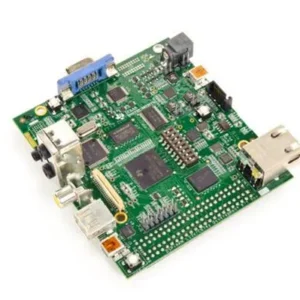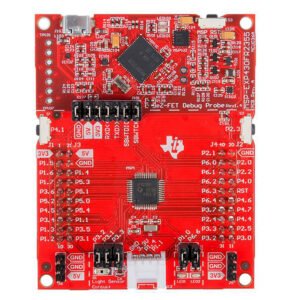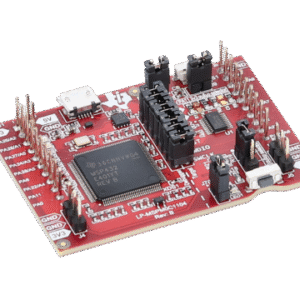Raspberry Pi 5 Raspberry Pi 5 Embedded MCU, DSP Evaluation Boards
- Breakthrough Compute & Graphics — 2.4 GHz quad-core Cortex-A76 with VideoCore VII (OpenGL ES 3.1 / Vulkan 1.2) drives dual 4Kp60 displays and smooth desktop/multimedia performance with ~2–3× CPU uplift vs. Pi 4.
- Next-Gen I/O with RP1 — Doubled per-port USB 3.0 (5 Gbps), dual 4-lane MIPI for dual cameras/displays, faster microSD SDR104, plus PCIe 2.0 x1 (via M.2 HAT) for NVMe SSD expansion.
- Deployment-Ready Design — On-board power button + PMIC, RTC header, USB-C PD (27 W recommended), Gigabit Ethernet with PoE+ HAT option, and a rich ecosystem (premium case with fan, Active Cooler, M.2/PoE+ HATs).
In Stock
Request a QuotePrice range: $85.00 through $205.00
Raspberry Pi 5 is a generational leap in CPU power, graphics, and connectivity. Powered by a 2.4 GHz quad-core 64-bit Arm Cortex-A76 and an 800 MHz VideoCore VII GPU, it comfortably drives dual 4Kp60 HDR displays, supports 4K HEVC hardware decode, and brings a brand-new RP1 in-house I/O controller that dramatically accelerates USB, camera/display, and storage expansion. With LPDDR4X-4267 memory (4 GB or 8 GB) and an upgraded power architecture, Raspberry Pi 5 excels in desktop computing, edge gateways, industrial control/HMI, AI experimentation, and rich multimedia capture/playback.
Compared with the previous generation, CPU throughput rises by roughly 2–3×, graphics are modernized with Vulkan 1.2 and OpenGL ES 3.1, single-port USB 3.0 bandwidth doubles, microSD runs faster in SDR104 mode, and PCIe 2.0 x1 arrives (via an M.2 HAT) for NVMe SSDs. A board-level power button, PMIC, and RTC add PC-like convenience to everyday use.
Key Features
-
Breakthrough compute performance
-
64-bit 2.4 GHz Cortex-A76 quad-core CPU for snappy desktop and parallel workloads
-
VideoCore VII @ 800 MHz with OpenGL ES 3.1 and Vulkan 1.2 for smooth UIs and light gaming
-
LPDDR4X-4267 (4 GB/8 GB) high-bandwidth memory for multitasking and AI prototyping
-
-
Re-engineered I/O with RP1 southbridge
-
2 × USB 3.0 (5 Gbps each)—per-port bandwidth effectively doubled for fast SSDs and capture devices
-
Dual 4-lane MIPI (CSI/DSI, 1.5 Gbps per lane) for dual cameras or dual displays
-
microSD SDR104 high-speed mode plus PCIe 2.0 x1 for NVMe via M.2 HAT
-
-
User-friendly power and management
-
On-board power button + PMIC for one-touch on/off and controlled shutdown
-
Real-time clock (RTC) with battery header
-
USB-C PD input sized for peak loads with the recommended 27 W supply
-
-
Complete ecosystem
-
27 W USB-C PD power supply for full-performance headroom
-
Premium case with integrated fan and improved airflow
-
Active Cooler (heatsink + fan) for sustained heavy workloads
-
RTC battery & MIPI cables for plug-and-play builds
-
M.2 and PoE+ HATs (for NVMe storage and Power over Ethernet expansion)
-
Specifications
| Category | Specifications |
|---|---|
| Processor | Quad-core Arm Cortex-A76, 64-bit, up to 2.4 GHz |
| GPU | VideoCore VII @ 800 MHz; OpenGL ES 3.1, Vulkan 1.2; 4K HEVC decode |
| Memory | 4 GB / 8 GB LPDDR4X-4267 |
| Storage | microSD (SDR104); PCIe 2.0 x1 (via M.2 HAT for NVMe SSD) |
| Display | Dual HDMI 2.0 up to 4Kp60 HDR; dual MIPI DSI (shared with CSI) |
| Camera | Dual MIPI CSI, 4-lane each, 1.5 Gbps/lane |
| Wireless | 802.11ac Wi-Fi, Bluetooth® 5.0 |
| Ethernet | Gigabit Ethernet; PoE+ via optional HAT |
| USB | 2 × USB 3.0 (5 Gbps/port), 2 × USB 2.0 |
| Expansion | 40-pin GPIO, PCIe, dual MIPI, UART debug, fan & debug headers |
| Power | USB-C PD; recommended 5.1 V/5 A (27 W supply); on-board power button & RTC |
| Form Factor | Classic Raspberry Pi footprint; compatible with most cases/mounts |
| Other | PMIC for fine-grained rails, software-controlled cooling, power/thermal telemetry |
Note: Some features depend on accessory/HAT selection, cabling, and thermal headroom; availability may vary by OS image and driver maturity.
Performance & Efficiency
The Cortex-A76 micro-architecture plus higher clocks deliver major gains in compilation, compression, crypto, and web toolchains. VideoCore VII modernizes the graphics stack, accelerating desktop composition, 4K decode, and 3D APIs (OpenGL ES 3.1/Vulkan 1.2). High-bandwidth LPDDR4X-4267 keeps AI inference and multitasking responsive, minimizing memory stalls under load.
RP1 Southbridge: I/O, Re-imagined
RP1, Raspberry Pi’s custom I/O controller, rebuilds the data paths around USB, MIPI, and SDIO:
-
USB 3.0 with per-port 5 Gbps keeps external SSDs, capture cards, and USB NICs humming in parallel.
-
Two 4-lane MIPI interfaces let you flexibly mix dual cameras, dual DSI displays, or hybrid topologies for CV + HMI.
-
Faster microSD in SDR104 mode, plus PCIe 2.0 x1 to unlock NVMe speeds via the M.2 HAT—ideal as a system or scratch disk.
Easier to Use, Easier to Deploy
-
PC-like power control with a physical power button and managed shutdown.
-
RTC header preserves time across outages—handy for field and offline nodes.
-
Fan and debug headers simplify active cooling and development workflows.
-
PoE+ option enables single-cable power + data for racks, ceilings, and remote runs.
Ecosystem & Accessories
-
27 W USB-C PD PSU: Ensures stable operation under peak CPU/GPU/USB draw.
-
Premium case with fan: Tuned airflow for long duty cycles.
-
Active Cooler: Heatsink + fan for sustained high-performance or hot environments.
-
RTC coin cell & MIPI cables: Plug-and-go reliability.
-
M.2 HAT / PoE+ HAT: Seamless NVMe storage and Ethernet power expansion.
Applications
-
Desktop & Education: Dual 4K displays, multi-tab browsing, office tools, programming courses, and graphics labs.
-
Industrial Automation & Gateways: Gigabit Ethernet + PoE+, PCIe peripherals, RTC, and controlled power-up for robust edge nodes.
-
Computer Vision & Multimedia: Dual-camera ingest, 4K hardware decode, USB3 capture—great for monitoring, machine vision, and smart kiosks.
-
AI Prototyping: High-bandwidth memory and PCIe accessories (e.g., accelerators, NVMe) for common inference frameworks.
-
Makers & IoT: 40-pin GPIO and a vast HAT ecosystem for sensing, control, and display prototypes.
Selection & Deployment Tips
-
Memory choice
-
4 GB: Education, light desktop, single-camera capture, general control.
-
8 GB: Heavy multitasking, dual 4K, in-memory datasets, AI workloads.
-
-
Storage strategy
-
For reliability: quality A2/U3 microSD.
-
For speed/endurance: M.2 HAT + NVMe SSD as system/data drive.
-
-
Thermal plan
-
Moderate loads: case with fan is usually sufficient.
-
Sustained/high ambient: consider Active Cooler or a well-ducted enclosure.
-
-
Power & peripherals
-
Use the 27 W PD adapter for headroom.
-
High-draw USB devices (HDDs/capture cards) may need their own power or a powered hub.
-
What’s in the Box / Options
-
Raspberry Pi 5 board (4 GB or 8 GB)
-
Optional: 27 W USB-C PSU, premium case with fan, Active Cooler, RTC coin cell, MIPI cables
-
Optional HATs: M.2 (NVMe), PoE+, camera/display expansion, and more
FAQ
Q: How much faster is it than Raspberry Pi 4?
A: Expect around 2–3× CPU uplift, a modernized VideoCore VII GPU, higher single-port USB 3.0 bandwidth, faster microSD, and new PCIe 2.0 x1 for NVMe.
Q: Can it run two 4K displays at once?
A: Yes—two HDMI 2.0 ports support dual 4Kp60 HDR (cable/monitor-dependent).
Q: How do I use an NVMe SSD?
A: Add the official M.2 HAT (PCIe 2.0 x1) and install an M.2 NVMe SSD for system or high-speed data.
Q: How do I power it over Ethernet?
A: Use the PoE+ HAT, which provides power via the Ethernet cable—ideal for racks and remote installs.
Summary
Raspberry Pi 5 upgrades compute, graphics, and I/O in one compact, efficient board. With the RP1 southbridge, PCIe, dual 4K, and doubled USB3 bandwidth, it unlocks professional-grade scenarios while retaining the classic Raspberry Pi footprint and ecosystem. Whether you need an affordable desktop, an edge AI/vision node, or a dependable industrial controller, Raspberry Pi 5 delivers performance, usability, and expandability in equal measure.
Want a tailored bill of materials and wiring/thermal plan for your project? Share your sensors/displays, power constraints, and environment—I’ll propose a ready-to-build setup.
Specification: Raspberry Pi 5 Embedded MCU, DSP Evaluation Boards
|
User Reviews
Only logged in customers who have purchased this product may leave a review.







There are no reviews yet.